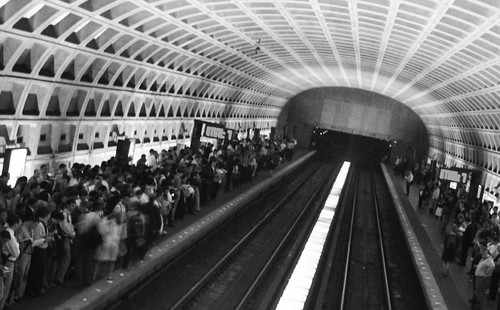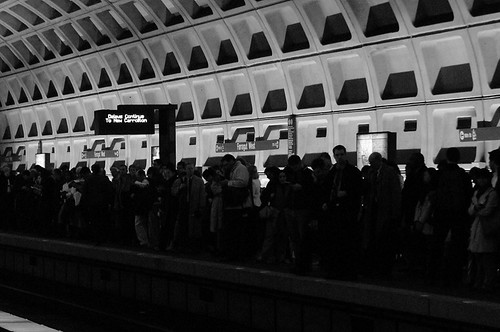
‘Horton #23 (26/365)’
courtesy of ‘Chris Rief aka Spodie Odie’
I was getting ready to head to work on Monday when I noticed that Twitter was all atwitter about the Orange and Blue lines being a mess. I usually head into town from Court House after 9:30, and usually congestion issues have worked themselves out by then.
But this was much bigger. A power cable outside Federal Triangle needed replacing, and this caused Metro to single track trains for roughly the duration of the morning rush hour. Even after rush hour ended, there were still residual issues with trains clumping and having to slow down.
I was trying to assess if I should work from home that day and looked at the next train arrival times for Court House. To my utter amazement, I saw that the next three trains were 8-car trains. When I decided to go in, I also saw that the two of the next three trains were also 8-cars. I was shocked, and dropped a note to Metro to find out what was going on.

‘good morning.’
courtesy of ‘volcanojw’
Essentially, what I was seeing was the residual effects of the delays in the system. These were mostly 8-car trains that had been scheduled already, but which had been delayed by the single tracking. I’m almost sure that one or more might have been phantom 8-car trains (6-car trains that are erroneously listed as 8 by the public information display system).
UPDATE: I misunderstood what Metro spokesman Ron Holzer told me. What did happen was that six more cars, in pairs, were added to existing trains to create three more 8-car trains than was planned.
My conversation with Metro spokesman Ron Holzer did point out that they try to be proactive in the use of what they term “gap trains.” These are trains that are not on the schedule but which can be deployed quickly to fill in any gaps left by having to remove a train from service. Sometimes, these trains are added in to relieve congestion, as well.
So how does Metro know when to deploy a gap train for congestion relief? In scheduled events, like a game or concert at the Verizon Center, Metro has gap trains at the ready, and send them in when the crowds start to exit. But in the case of train or track issues, the agency has traffic checkers at key stations, and central control can bring up platform cameras to see what’s going on.
In Monday’s incident on the Orange line, a 6-car gap train was added six cars were added to create three more 8-car trains than was planned, but “no other capacity could be added because of the single tracking,” Holzer said.

‘the long wait home’
courtesy of ‘philliefan99’
Holzer also points out that as part of Metro’s ongoing improvements and in an effort to ease congestion due to the Cherry Blossom Festival and the onset of tourist season, the agency is adding 8-car trains. This expanded capacity will continue even after the festival is over.
For Monday’s commute, this was but a band-aid on a huge cut. There’s no getting around single tracking when there are critical issues that have to be fixed immediately. This power cable repair had to be done, and there was no way to postpone that work. Unfortunately, and we’ve talked about this before, until the system is in a state of good repair, issues like this will not be uncommon.
One other thing I think Metro can improve on is communications. Single tracking was done by the end of rush hour, and the problem was known to be a power cable. Yet, even by 10a, my train operator was saying that we were single tracking. There has to be clear communication, otherwise it appears that various parts of Metro are not in sync.
I also think that some of the pictures I saw of crowding on the platforms were very scary. This wasn’t an incident where people had to be offloaded on one platform, it was single tracking during rush hour. In other words, the station managers should have expected platforms to fill up, and should have started to stop people from entering the station until there was space for them.
I thought PIDS stood for Perennially Incorrect Display System?
OMG! Really 8 car trains? Who gives a toss about you Samer? JK!